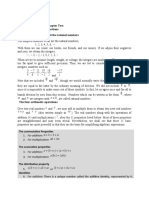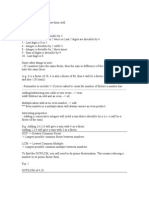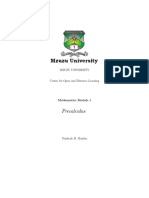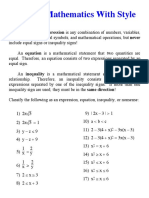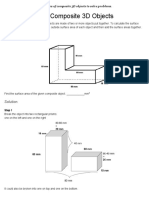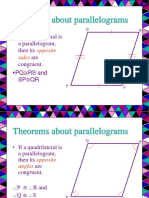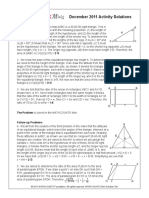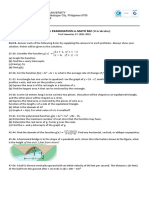Function and
Relations
(Part 1)
By
O.A Esan
Walter Sisulu University
Learning outcome
At the end of this course, student should understand the following:
Concept of function.
Introduction to different functions that we will encounter in this
course.
Summary of function and their important properties.
Number system
We begin by introducing the different sets of numbers we will be
using in this course and show the important properties of each.
The first set is the natural numbers, which are the numbers that we
would use to count object
The symbol N will be use for this set and the set notation is written
as
N={1,2,3,…}
Number System …CONTD
It is also important to consider the action of the basic operations of
arithmetic in the number set.
The basic arithmetic such as addition (+), multiplication (X),
subtraction(-) and division (/).
We can see that any two numbers can be added to give another.
Likewise for multiplication. Then we say that the set N is close
under addition multiplication number sets
Integers
However, if we subtract one natural number from another we do not
always get another natural number.
For example 2-5 = -3
And -3 is not in N. so N is not closed under subtraction
Thus, it is possible to create a set of numbers which is closed
under subtraction and this is called the set of all integers, Z={…-
2,-1,0,1,2,…}
This number is obtained by taking all the members of N with a
negative sign in front as well as N itself, and also the number 0.
There is still one more elementary arithmetic operation to consider,
namely division.
Z is clearly not under division
For example 2 divided by 3 is not an integer
So there is need to enlarge our set of numbers again to make the
resultant set closed under division just like the other three
operations
We define the set of rational numbers denoted by Q of the form
a/d where a and d are both in Z but d is not equal to zero
Rational Number
We may also ask if there is some convenient way of saying definitely
whether a given number is rational or irrational.
The key to this is in the decimal representation of any real number.
Any rational number will have a decimal representation which either
terminates (that is after a finite number of digits only zeros occur) or
which has a sequence of digits which reoccurs (repeating finite
patterns)
For example:
1/5 =0.2
1/3 = 0.333… and every digit is 3 from then on
1/13=0.07692320769. This has a clearly recognizable patterns
Irrational Number
Irrational number will have a non-terminating decimal representation
in which no finite pattern occurs
Example
E.g.,
inequalities
One way of comparing two real numbers is to ask which of them is
larger.
Another way of asking this is to ask which one is rank further to the
right on the real line
The following manipulations are true for inequalities:
Rule 1: If a < b and then a + c < b + c (for all c)
Rule 2: If a < b and c < d then a + c < b + d
Rule 3: If a < b and c > 0 then ac < bc
Rule 4: If a < b and c <0 then ac > bc
Rule 5: if 0 < a < b then 0 < 1/b < 1/a
Explanation of the rules:
Rule 1 says that one can add the same number to each side of an
inequality without changing the inequality sign.
Rule 2 shows how two inequalities of the same kind can be combined
additively to give an equality of the same type (this is not true in
a subtractive sense).
Rule 3 says that when an inequality is multiplied by any positive
number the direction of the inequality remains unchanged.
Rule 4 states that if one multiplies each side of an inequality by the
same negative number then the direction of the inequality sign
changes.
Rule 5 states that if reciprocals are taken of two positive
numbers in an inequality, then the reciprocals satisfy the
reversed inequality (but remain positive).
Inequalities between function
We often need to solve for possible numerical values an inequality
between two different function of an unknown
Example
2x – 3 < 7x + 2
Solution
Using the rule 1 first, add -2x to each side
-2x + 2x -3 < -2x + 7x +2
-3 < 5x + 2
Example 1 ….CONTS
Again use rule 1 to add -2 to each side, then
-2 – 3 < 5x -2 +2
-5 < 5x
Finally, we use rule 3 to multiply by 1/5
1/5 * -5 < 1/5 *5x
-1 < x
Example 2
4 <= 3x – 2 < 13
Solution
Adding 2 across the inequality (rule 1) gives
2 + 4 <= 3x + 2 - 2 < 2 + 13
6 <= 3x < 15
Multiplying by 1/3 across (rule 3) gives
1/3 * 6 <= 1/3 * 3x < 1/3 *15
2 <= x < 5
Absolute Value
The absolute value or magnitude of a real number a is denoted by |a|
And is defined b
We can conveniently think of absolute value of a number as the distance it lies from
zero on the real line, since we will always regard distance as positive.
Examples
|-2| =2
|5| = 5
PROPERTIES OF ABSOLUTE VALUE
Property 1:
|ab| = |a| |b|
Property 2:
|a/b| = |a|/|b|
Property 3:
In addition, for solving equations or inequalities
involving absolute value the following rules are
useful (a is assumed positive in each)
Property 4:
|x|= a if and only if x = +- a
Property 5:
|x| < a if and only if –a < x < a
Property 6:
|x| > a if and only if x > a or x < -a
Example 1
Solve |x -2| < 5
Solution
From property 5, we can say
-5 < x -2 < 5
Adding 2 across
+2 - 5 < x +2 -2 < 2 + 5
-3 < x < 7
Example 2
Solve |x -2| > 5
Solution
From property 6, we have equivalently,
x -2 > 5 or x - 2 < -5
Add 2 across
x +2 – 2 > 2 + 5 or x + 2 -2 < 2 – 5
x > 7 or x < -3
Example 3
THANK YOU
……… TO BE CONTINUED NEXT CLASS



